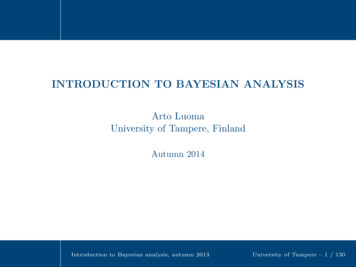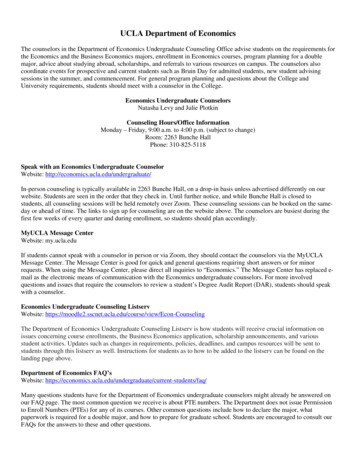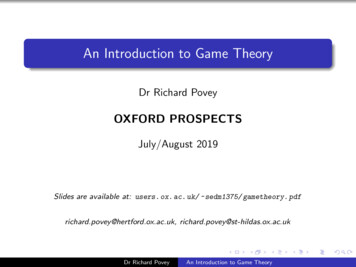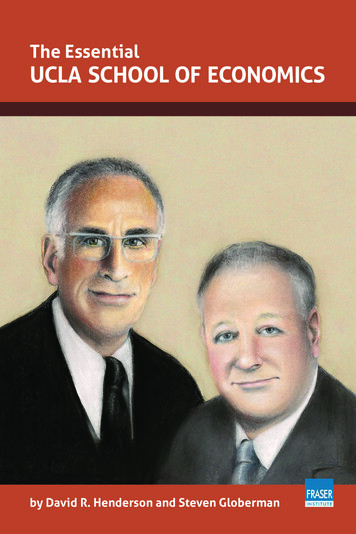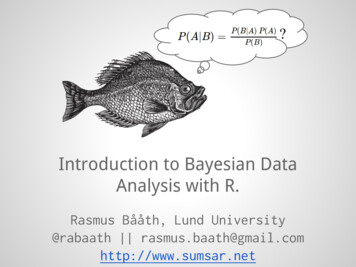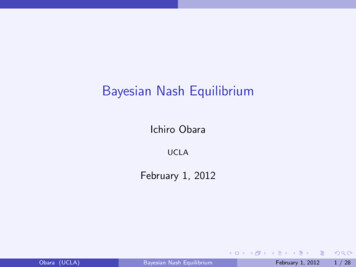
Transcription
Bayesian Nash EquilibriumIchiro ObaraUCLAFebruary 1, 2012Obara (UCLA)Bayesian Nash EquilibriumFebruary 1, 20121 / 28
Bayesian GameBayesian GameWe like to model situations where each party holds some privateinformation. For example,IA bidder does not know other bidders’ values in auction.IA trader has some insider information about a recent technologicalinnovation by some firm.I.Obara (UCLA)Bayesian Nash EquilibriumFebruary 1, 20122 / 28
Bayesian GameBayesian GameBayesian GameA Bayesian Game consists ofplayer: a finite set Nstate: a set Ωaction: a set Ai for each i Ntype: a set Ti for each i N Qbelief: a function pi : Ti Ω j6 i Tj for each i Npayoff: a function ui : A Ω for each i N.Obara (UCLA)Bayesian Nash EquilibriumFebruary 1, 20123 / 28
Bayesian GameBayesian GameInterpretation:IΩ is a set of possible states of nature that determine all physicalsetup of the game (payoffs).ITi is the set of i’s private types that encode player i’sinformation/knowledge (ex. private signal).Ipi is player i’s interim belief about the state and the other players’types.We are already familiar with the basic idea of BG: correlated equilibrium andvariety of interpretations of mixed strategy (Harsanyi’s purification argumentetc.) are some special cases. BG introduces incomplete information intogames in a very flexible way.Obara (UCLA)Bayesian Nash EquilibriumFebruary 1, 20124 / 28
Bayesian GameBayesian GameBayesian games are often described more simply by eliminating Ω asfollows.IIPInterim belief on T i : pi (t i ti ) : ω Ω pi (ω, t i ti )PPayoff on A T : ui (a, t) : ω ui (a, ω)pi (ω t)where pi (ω t) P pi (ω,t i ti ).ω Ω pi (ω,t i ti )In this formulation, type encodes both payoff and belief.Obara (UCLA)Bayesian Nash EquilibriumFebruary 1, 20125 / 28
Bayesian GameExample: AuctionConsider the standard model of first price auction where each bidderonly knows her value and have a belief about the other bidders’values. This is a simple Bayesian game whereIthe set of players (bidders) is NIthe set of states is V1 ., VnIthe set of actions for bidder i is Ai Ithe set of types for bidder i is ViIbidder i’s interim belief is pi (v i vi ).Ibidder i’s payoff is ui (b, v ) 1(bi maxj6 i bj )(vi bi ).Obara (UCLA)Bayesian Nash EquilibriumFebruary 1, 20126 / 28
Bayesian GameCommon Prior Assumption (CPA)We almost always assume that all the interim beliefs are derived fromthe same prior. That is, we assume common prior.Common Prior AssumptionA Bayesian Game (N, Ω, (Ai ), (Ti ), (pi ), (ui )) satisfies the common priorQassumption if there exists p (Ω i N Ti ) such thatpi (ω, t i ti ), ti Ti , i N are all conditional distributions derived from p.This assumption is not entirely convincing, but it is a useful one.Obara (UCLA)Bayesian Nash EquilibriumFebruary 1, 20127 / 28
Bayesian Nash EquilibriumBayesian Nash EquilibriumPlayer i’s strategy si is a mapping from Ti to Ai . Let Si be the set ofplayer i’s strategies. It is like a contingent plan of actions.Given s (s1 , ., sn ), player i’s interim expected payoff for type ti is E ui: X X si (ti ), s i (et i ) , ωe tiui ((si (ti ), s i (t i )) , ω) pi (ω, t i ti )ω Ω t i T iA strategy profile s (s1 , ., sn ) is a Bayesian Nash Equilibrium iffor every i N, si assigns an optimal action for each ti thatmaximizes player i’s interim expected payoff.Obara (UCLA)Bayesian Nash EquilibriumFebruary 1, 20128 / 28
Bayesian Nash EquilibriumBayesian Nash EquilibriumHere is a formal definition.Bayesian Nash Equilibriums (s1 , ., sn ) S is a Bayesian Nash Equilibrium if eE ui ( si (ti ), s i(t i ) , ωe ) ti e E ui ( ai , s i(t i ) , ωe ) tiholds for every ai Ai and ti Ti , for every i N.Obara (UCLA)Bayesian Nash EquilibriumFebruary 1, 20129 / 28
Bayesian Nash EquilibriumComments.A Bayesian Nash equilibrium can be regarded as a Nash Equilibriumof some appropriately defined strategic game.IOne interpretation is to regard each type as a distinct player and regardPthe game as a strategic game among such i Ti players (cf. definitionin O&R). Then a BNE can be regarded as a NE of this strategic game.ISuppose that there exists common prior p. Let Ui (s) E ui ((si (eti ), s i (et i )), ωe ) be player i’s ex ante expectedpayoff given s S. Then a BNE s is a NE of strategic game(N, (Si ), (Ui )).Obara (UCLA)Bayesian Nash EquilibriumFebruary 1, 201210 / 28
Bayesian Nash EquilibriumComments.Suppose that there are finite actions and finite types for each player.In this case, the whole game can be regarded as a finite strategicgame (in either interpretation). In this setting, we can allow eachtype to randomize over actions as we did in mixed strategy NE. Thenwe can define a mixed strategy BNE and it follows immediately fromthe existence of MSNE that there exists a MSBNE.Obara (UCLA)Bayesian Nash EquilibriumFebruary 1, 201211 / 28
ApplicationsExample 1: Second Price AuctionSuppose that v (v1 , ., vn ) is generated by common priorp ([0, 1]n ) in second price auction.Since it is a dominant action to bid one’s true value, bidders’ beliefsare not relevant for their decision. Hence b (b1 , ., bn ), wherebi (vi ) vi , is a BNE.Obara (UCLA)Bayesian Nash EquilibriumFebruary 1, 201212 / 28
ApplicationsExample 2: First Price AuctionAssume that vi is i.i.d. across bidders and follow the uniformdistribution on [0, 1].We look for a symmetric BNE (b , ., b ) in first price auction.We use “guess and verify method”: we assume b(v ) θv for some θ,then verify that this strategy is in fact optimal against itself for someθ.Obara (UCLA)Bayesian Nash EquilibriumFebruary 1, 201213 / 28
ApplicationsExample 2: First Price AuctionBidder i’s expected payoff with value vi [0, 1] and bid bi [0, 1] is biPr(win bi )(vi bi ) Pr max vj (vi bi )j6 iθ n 1bi(vi bi ) θThe first order condition is: n 2 n 1bin 1 bi(vi bi ) 0θθθn 1n vimaximizes the payoff given vi (independent of θ).Hence b (v ) n 1n vis the optimal bid for each bidder when all the otherbidders are using it. That is, it is a symmetric BNE for every bidder tofollow b (v ) Obara (UCLA)n 1n v.Bayesian Nash EquilibriumFebruary 1, 201214 / 28
ApplicationsExample 2: First Price AuctionNext we consider general cumulative distribution function F (still i.i.d. isassumed).Assume that the symmetric BNE b is strictly increasing and differentiable.The expected payoff for type v bidder isPr(win b)(v b) F (b 1 (b))n 1 (v b)The type v bidder’s optimal bid bb(v ) is obtained from the following firstorder condition:(n 1)f (b 1 (bb(v )))F (b 1 (bb(v )))n 2(v bb(v ))b 0 (b 1 (bb(v )) F (b 1 (bb(v )))n 1 0Obara (UCLA)Bayesian Nash EquilibriumFebruary 1, 201215 / 28
ApplicationsExample 2: First Price AuctionSince bb(v ) b (v ) in equilibrium, this differential equation simplifies to 0F (v )n 1(v b(v )) F (v )n 1 0.b 0 (v )Solving this, we obtainIRv b (v ) 0 0F (x)n 1 xdx.F (v )n 1or, by integration by parts,Rvb (v ) v I0F (x)n 1 dxF (v )n 1We can verify that (1) this is in fact strictly increasing anddifferentiable and (2) second order condition is satisfied.Obara (UCLA)Bayesian Nash EquilibriumFebruary 1, 201216 / 28
ApplicationsExample 2: First Price AuctionBayesian Nash equilibrium for the first price auctionIt is a Bayesian Nash equilibrium for every bidder to follow the strategyb(v ) v Rv0F (x)n 1 dxF (v )n 1Obara (UCLA)for the first price auction with i.i.d. private value.Bayesian Nash EquilibriumFebruary 1, 201217 / 28
ApplicationsExample 3: Cournot Competition with Private CostConsider a Cournot model where each firm’s cost is privateinformation and drawn from [0, 1] according to the same CDF Findependently. Let c be the average cost.Assume that the inverse demand function is p(Q) 3 Q.Let’s try to find a symmetric BNE (q , ., q ).Obara (UCLA)Bayesian Nash EquilibriumFebruary 1, 201218 / 28
ApplicationsExample 3: Cournot Competition with Private CostFirm i’s expected profit when its cost is ci and qi is produced isπi (qi , q ) E [(3 qi (n 1)q (ec ) c i ) qi ]From FOC, we obtainqi (ci ) 3 (n 1)E [q (ec )] ci2Taking the expectation and imposing symmetry, we have E [q (ec )] Hence (q , ., q ), where q (c) Obara (UCLA)3 cn 1 c c2 ,Bayesian Nash Equilibrium3 cn 1 .is the symmetric BNE.February 1, 201219 / 28
ApplicationsExample 4: Double Auction (Chatterjee and Samuelson1983)One buyer and one seller.Buyer’s value and and seller’s value is independently and uniformlydistributed on [0, 1].Buyer’s payoff is vb p when trading at price p, 0 otherwise. Seller’spayoff is p vs when trading at price p, 0 otherwise.Buyer’s strategy is pb : [0, 1] [0, 1] (price offer) and seller’s strategyps : [0, 1] [0, 1] (asking price).Trade occurs at priceObara (UCLA)pb ps2only if pb ps . Otherwise no trade.Bayesian Nash EquilibriumFebruary 1, 201220 / 28
ApplicationsExample 4: Double AuctionLook for a linear BNE pb (vb ) ab cb vb , ps (vs ) as cs vs .Given this linear strategy by the seller, the buyer’s problem is 1as pbpb asmax vb pb pb22csFrom the first order condition, we obtain21pb (vb ) vb as33Obara (UCLA)Bayesian Nash EquilibriumFebruary 1, 201221 / 28
ApplicationsExample 4: Double AuctionSeller’s problem is 1p s ab c bab cb psmaxps vsps22cbFrom the first order condition, we obtain21ps (vs ) vs (ab cb )33Obara (UCLA)Bayesian Nash EquilibriumFebruary 1, 201222 / 28
ApplicationsExample 4: Double AuctionMatching coefficients, we get ab 1/12, as 1/4, cb cs 2/3.Hence we find one BNE:pb (vb ) ps (vs ) Obara (UCLA)21vb 31221vs 34Bayesian Nash EquilibriumFebruary 1, 201223 / 28
ApplicationsExample 4: Double AuctionRemarkAn allocation is efficient if trade occurs whenever vb vs . So thisBNE does not generate an efficient allocation.In this uniform distribution environment, however, this BNE is themost efficient one. Thus it is impossible to achieve the efficientallocation by any BNE in double auction.This inefficiency result is very general. The efficient allocation cannotbe achieved by ANY Bayesian Nash Equilibrium in ANY mechanism.Obara (UCLA)Bayesian Nash EquilibriumFebruary 1, 201224 / 28
ApplicationsExample 5: Global Game (Carlson and van Damme 1993)There are two investors i 1, 2. Each investor chooses whether topurchase risky asset (RA) or safe asset (SA).Each investor’s payoff depends on the state of economy θ andthe other investor’s decision.Information Structure:Iθ is “uniformly distributed” on .IInvestor i observes a private signal ti θ i , where i follow N(0, σ).IGiven ti , investor i believes that θi is distributed according to N(ti , σ) and t i is distributed according to N(ti , 2σ).Obara (UCLA)Bayesian Nash EquilibriumFebruary 1, 201225 / 28
ApplicationsExample 5: Global GameThe payoff matrix given each realization of θ is as follows.RASARAq,qq-1,0SA0, q-10,0Note that, if θ is publicly known,IRA is a dominant action when θ 1.ISA is a dominant action when θ 0IBoth (RA, RA) and (SA, SA) is a NE when 0 θ 1.Obara (UCLA)Bayesian Nash EquilibriumFebruary 1, 201226 / 28
ApplicationsExample 5: Global GameLet b(x) be a solution for t Φ x t 2σ 0 given x. The interpretation ofb(x) is that b(x) should be an investor’s optimal cutoff point (i.e. chooseSA if t is below b(x) and RA if t is above b(x)) when the other investor’scutoff point is x.b(x) looks as follows. It is strictly increasing and crosses the 45 degree lineat x 0.5.10Obara (UCLA)00.5Bayesian Nash Equilibrium1February 1, 201227 / 28
ApplicationsExample 5: Global GameWe can show that this is the unique BNE by applying iteratedelimination of strictly dominated actions for each type as follows.IFor ti 0, i 1, 2, RA is strictly dominated. So delete RA for every tistrictly below 0.IThen we can delete RA for every ti b(0)( 0) for i 1, 2 (why?).IWe can delete RA for every ti below b 2 (0) b 3 (0) .ISo we can delete RA for every ti 0.5 in the limit.ISimilarly we can delete SA for every ti above b 2 (0) b 3 (0) .,hence for every ti 0.5 in the limit.Obara (UCLA)Bayesian Nash EquilibriumFebruary 1, 201228 / 28
Bayesian Game Bayesian Game We like to model situations where each party holds some private information. For example, I A bidder does not know other bidders’ values in auction. I A trader has some insider information about a recent technological innovation by some rm. I. Obara



